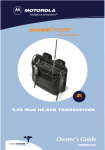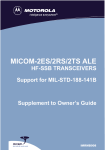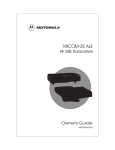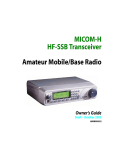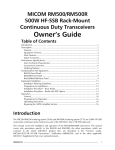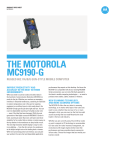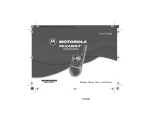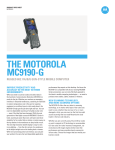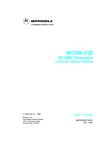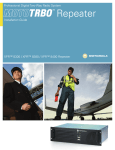Download Motorola MICOM-2TS Specifications
Transcript
MICOM-2ES/2RS/2TS ALE HF-SSB TRANSCEIVERS Supplement to Owner’s Guide best radio for worst events 6886872J01 COMMERCIAL WARRANTY (STANDARD) Motorola radio communications products are warranted to be free from defects in material and workmanship for a period of ONE (1) YEAR, (except for crystals and channel elements which are warranted for a period of ten (10) years) from the date of shipment. Parts, including crystals and channel elements, will be replaced free of charge for the full warranty period but the labor to replace detective parts will only be provided for One Hundred-Twenty (120) days from the date of shipment. Thereafter purchaser must pay for the labor involved in repairing the product or replacing the parts at the prevailing rates together with any transportation charges to or from the place where warranty service is provided. This express warranty is extended by Motorola Communications and Electronics Inc., 1301 E. Algonquin Road, Schaumburg, Illinois 60196, to the original purchaser only, and only to those purchasing for purpose of leasing or solely for commercial, industrial, or governmental use. THIS WARRANTY IS GIVEN IN LIEU OF ALL OTHER WARRANTIES EXPRESS OR IMPLIED WHICH ARE SPECIFICALLY EXCLUDED, INCLUDING WARRANTIES OF MERCHANTABILITY OR FITNESS FOR A PARTICULAR PURPOSE. IN NO EVENT SHALL MOTOROLA BE LIABLE FOR INCIDENTAL OR CONSEQUENTIAL DAMAGES TO THE FULL EXTENT SUCH MAY BE DISCLAIMED BY LAW. In the event of a defect, malfunction or failure to conform to specifications established by Seller, or if appropriate, to specifications accepted by Seller in writing, during the period shown. Motorola, at its option, will either repair or replace the product or refund the purchase price thereof, and such action on the part of Motorola shall be the full extent of Motorola's liability hereunder. This warranty is void if: a. The product is used in other than its normal and customary manner. b. The product has been subject to misuse, accident, neglect or damage. c. Unauthorized alterations or repairs have been made, or unapproved parts used in the equipment. This warranty extends only to individual products, batteries are excluded, but carry their own separate limited warranty. Because each radio system is unique, Motorola disclaims liability for range, coverage, or operation of the system as a whole under this warranty except by a separate written agreement signed by an officer of Motorola. Non-Motorola manufactured products are excluded from this warranty, but subject to the warranty provided by their manufacturers, a copy of which will be supplied to you on specific written request. To obtain performance of this warranty, purchaser must contact [email protected]. This warranty applies only within the United States. COMPUTER SOFTWARE COPYRIGHTS The Motorola products described in this instruction manual may include copyrighted Motorola computer programs stored in semiconductor memories or other media. Laws in the United States and other countries preserve for Motorola certain exclusive rights for copyrighted computer programs, including the exclusive right to copy or reproduce in any form the copyrighted computer program. Accordingly, any copyrighted Motorola computer programs contained in the Motorola products described in this instruction manual may not be copied or reproduced in any manner without the express written permission of Motorola. Furthermore, the purchase of Motorola products shall not be deemed to grant either directly or by implication, estoppel, or otherwise, any license under the copyrights, patents or patent applications of Motorola, except for the normal non-exclusive, royalty free license to use that arises by operation of law in the sale of a product. best radio for worst events MICOM-2ES/2RS/2TS ALE HF-SSB TRANSCEIVER Motorola 1720 West Paul Dirac Drive, Tallahassee 32310 FL, USA Supplement to Owner’s Guide Cat. No. 6886872J01 Warnings, Cautions and Notes Warnings, Cautions and Notes The following notations are used to place special emphasis on procedures, or to call attention to precautionary measures. An operating procedure, practice and so forth, which if not followed correctly, could result in personal injury, or loss of life. Warning An operating procedure, practice and so forth, which if not followed correctly, could result in damage to, or destruction of equipment. Important An operating procedure, condition and so forth, to which special attention should be paid. Note General Safety Precautions The following are general safety precautions that are not related to any specific procedures and therefore do not appear elsewhere in this publication. These are recommended precautions that personnel must understand and apply, in addition to the precautions listed in the Information for Safe, Efficient Operation section. Warning High Voltage Do not touch the antenna and the RF connectors when the transceiver operates. During transmission, high RF voltages appear at the RF connectors, the antenna cables, and on the antenna itself. These voltages may cause severe injury or even death on contact. Operating and maintenance personnel must be familiar with the applicable safety requirements before attempting to install or operate the transceiver. Severe injury or death could result from failure to comply with the safety practices. _________________________________________________________________________________________________ i MICOM-2ES/2RS/2TS ALE Supplement to Owner’s Guide Information for Safe, Efficient Operation Product Safety and RF Exposure for Mobile Two-Way Radios Installed in Vehicles or as Fixed Site Control Stations Caution BEFORE USING THIS RADIO, READ THIS BOOKLET WHICH CONTAINS IMPORTANT OPERATING INSTRUCTIONS FOR SAFE USAGE AND RF ENERGY AWARENESS AND CONTROL INFORMATION FOR COMPLIANCE WITH RF ENERGY EXPOSURE LIMITS IN APPLICABLE NATIONAL AND INTERNATIONAL STANDARDS. The information provided in this document supersedes the general safety information contained in user guides published prior to February 2002. Compliance with RF Energy Exposure Standards NOTICE This radio is intended for use in occupational/controlled applications where users have been made aware of the potential for exposure and can exercise control over their exposure. This radio device is NOT authorized for general population, consumer or similar use. Motorola, Inc. 2003 8000 W. Sunrise Blvd., Ft. Lauderdale, FL 33322 Printed in USA. 7/03 ii ________________________________________________________________________________________________ Warnings, Cautions and Notes Federal Communication Commission Regulations The FCC has established limits for safe exposure to radio frequency (RF) emissions from mobile two-way radios. The FCC requires manufacturers to demonstrate compliance with RF exposure limits before mobile two-way radios can be marketed In the U.S. When two-way radios are approved for occupational/controlled environment exposure limits, the FCC requires users to be fully aware of, and exercise control over, their exposure. Awareness and control of RF exposure can be accomplished by education or training through appropriate means such as information and instructions in user manuals or safety booklets, or other appropriate means. This user safety booklet includes useful information about RF exposure and helpful instructions on how to control your RF exposure. Your Motorola two-way radio is designed and tested to comply with a number of national and international standards and guidelines (listed below) regarding human exposure to radio frequency electromagnetic energy. This radio complies with the IEEE (FCC) and ICNIRP exposure limits for occupational/controlled RF exposure environments at usage factors of up to 50% talk-50% listen. In terms of measuring RF energy for compliance with FCC exposure guidelines, your radio radiates measurable RF energy only while it is transmitting (during talking), not when it is receiving (listening) or in standby mode. Your Motorola two-way radio complies with the following RF energy exposure standards and guidelines: • United States Federal Communications Commission, Code of Federal Regulations; 47CFR part 2 sub-part J • American National Standards Institute (ANSI) / Institute of Electrical and Electronic Engineers (IEEE) C95.1-1992 • Institute of Electrical and Electronic Engineers (IEEE) C95.1-1999 Edition • International Commission on Non-Ionizing Radiation Protection (ICNIRP) 1998 • Ministry of Health (Canada) Safety Code 6: Limits of Human Exposure to Radiofrequency Electromagnetic Fields in the Frequency Range from 3 kHz to 300 GHz, 1999 • Australian Communications Authority Radiocommunications (Electromagnetic Radiation – Human Exposure) Standard, 2001 • ANATEL, Brasil Regulatory Authority, Resolution 256 (April 11, 2001). Additional Requirements for SMR, Cellular and PCS Product Certification. _________________________________________________________________________________________________ iii MICOM-2ES/2RS/2TS ALE Supplement to Owner’s Guide Compliance and Control Guidelines and Operating Instructions for Mobile Two-Way Radios Installed in Vehicles To control your exposure and ensure compliance with the occupational/controlled environment exposure limits, always adhere to the following procedures: • To transmit (talk), push the Push-To-Talk (PTT) button; to receive, release the PTT button. Transmit only when people outside the vehicle are at least 7 feet from a properly installed, externally-mounted antenna. • Install mobile antennas at the center of the roof or the center of the trunk deck per specific guidelines and instructions in the Radio Installation Manual. These mobile antenna installation guidelines are limited to metal body vehicles. Use only the Motorola-approved, supplied antenna or a Motorolaapproved replacement antenna. Use of non-Motorola-approved antennas, modifications, or attachments could damage the radio and may violate FCC regulations. Compliance and Control Guidelines and Operating Instructions for Mobile Two-Way Radios Installed as Fixed Site Control Stations If mobile radio equipment is installed at a fixed location and operated as a control station or as a fixed unit, the antenna installation must comply with the following requirements in order to ensure optimal performance and compliance with the RF energy exposure limits in the standards and guidelines listed in the Federal Communication Commission Regulations section. iv • The antenna should be mounted outside the building on the roof or a tower if at all possible. • As with all fixed site antenna installations, it is the responsibility of the licensee to manage the site in accordance with applicable regulatory requirements and may require additional compliance actions such as site survey measurements, signage, and site access restrictions in order to ensure that exposure limits are not exceeded. ________________________________________________________________________________________________ Warnings, Cautions and Notes Electromagnetic Interference/Compatibility Note Nearly every electronic device is susceptible to electromagnetic interference (EMI) if inadequately shielded, designed, or otherwise configured for electromagnetic compatibility. It may be necessary to conduct compatibility testing to determine if any electronic equipment used in or around vehicles or near fixed site antenna is sensitive to external RF energy or if any procedures need to be followed to eliminate or mitigate the potential for interaction between the radio transmitter and the equipment or device. Facilities To avoid electromagnetic interference and/or compatibility conflicts, turn off your radio in any facility where posted notices instruct you to do so. Hospitals or health care facilities may be using equipment that is sensitive to external RF energy. Vehicles To avoid possible interaction between the radio transmitter and any vehicle electronic control modules, for example, ABS, engine, or transmission controls, the radio should be installed only by an experienced installer and that the following precautions be used when installing the radio: 1. 2. 3. Refer to the manufacturer's instructions or other technical bulletins for recommendations on radio installation. Before installing the radio, determine the location of the electronic control modules and their harnesses in the vehicle. Route all radio wiring, including the antenna transmission line, as far away as possible from the electronic control units and associated wiring. Driver Safety Check the laws and regulations on the use of radios in the area where you drive. Always obey them. When using your radio while driving, please: • Give full attention to driving and to the road. • Pull off the road and park before making or answering a call if driving conditions so require. _________________________________________________________________________________________________ v MICOM-2ES/2RS/2TS ALE Supplement to Owner’s Guide Operational Warnings For Vehicles with an Air Bag Warning Do not mount or place a mobile radio in the area over an air bag deployment area. Air bags inflate with great force. If a radio Is placed in the air bag deployment area and the air bag inflates, the radio may be propelled with great force and cause serious injury to occupants of the vehicle. Potentially Explosive Atmospheres Turn off your radio prior to entering any area with a potentially explosive atmosphere. Sparks in a potentially explosive atmosphere can cause an explosion or fire resulting in bodily injury or even death. The areas with potentially explosive atmospheres include fueling areas such as below decks on boats, fuel or chemical transfer or storage facilities, and areas where the air contains chemicals or particles such as grain, dust or metal powders. Areas with potentially explosive atmospheres are often, but not always, posted. Blasting Caps and Blasting Areas Warning vi To avoid possible interference with blasting operations, turn off warning your radio when you are near electrical blasting caps, in a blasting area, or in areas posted: "Turn off twoway radio". Obey all signs and instructions. For radios installed in vehicles fueled by liquefied petroleum gas, refer to the (U.S.) National Fire Protection Association standard, NFPA 58, for storage, handling, and/or container information. For a copy of the LP-gas standard, NFPA 58, contact the National Fire Protection Association, One Battery Park, Quincy, MA. ________________________________________________________________________________________________ Table of Contents Table of Contents Page Introduction .................................................................................................... 1 New Model Information ................................................................................. 1 44-Pin Accessories Connector........................................................................ 1 Functional Enhancements............................................................................... 4 Additional MICOM-2 Features ...................................................................... 8 Display Modes .......................................................................................... 8 Receive Level Bar..................................................................................... 8 VFO Operation ......................................................................................... 9 BandWidth Filters..................................................................................... 10 New Channel/Frequency/Scan/Link Mode Features ................................ 12 New ALE Features.................................................................................... 14 VP-116 Mini Voice Privacy Unit Interface (Optional)............................. 20 PPS-100 Pre-Post Selector (Optional) ...................................................... 29 _________________________________________________________________________________________________ vii MICOM-2ES/2RS/2TS ALE Supplement to Owner’s Guide viii ________________________________________________________________________________________________ Introduction Introduction This Supplement to the “MICOM-2E/2R ALE HF-SSB Transceiver Owner’s Guide”, Publication 68P02952C60-A, provides you with information on additional features, options and MICOM-2 models, which are not documented in the Owner’s Guide. The information presented in this Supplement covers the new versions (Version CK) of the MICOM-2E/2RS/2TS ALE HF-SSB transceivers. The new versions use enhanced hardware and provide additional ALE capabilities. Externally, the new versions are similar to the previous MICOM-2. However, changes have been made in the wiring of the 44-pin accessories connector located on the rear panel, relative to the 44-pin connector used by the previous versions. The information appearing in this Supplement is intended for use with the Owner’s Guide, MICOM-2E/2RS/2TS ALE HF-SSB Transceivers, Publication 68P02952C60-A. New Model Information The new transceiver versions have been assigned new model numbers, as follows: MICOM-2ES Model M80AMNOKV5CK MICOM-2ETS Model M81AMNOKV5CK MICOM-2RS Model M85AMNOKV5CK 44-Pin Accessories Connector Table 1 lists the current functions of the 44-pin accessories connector, J5. Asterisks * appear in the Designation column next to the pins whose function has changed, relative to previous equipment versions. Notes 1. The information appearing in Table 1 supersedes any previous information provided in the Owner’s Guide (Publication 68P02952C60-A). 2. You can continue using the fixed adapter accessory for MICOM-2ES, MICOM-2ETS and MICOM-2RS (Part No. 09MB000011). This accessory interfaces between the 44-pin connector and older 25-pin accessories. _________________________________________________________________________________________________ 1 MICOM-2ES/2RS/2TS ALE Supplement to Owner’s Guide Table 1. 44-Pin Accessories Connector, Pin Functions Pin 2 Designation Description 1 SPKR- Differential output to the external 8Ω, 8W speaker 2 STOP SCAN Digital control input for stop scan function 3 SPKR+ Differential output to the external 8Ω, 8W speaker 4 EXT RX AUDIO+ 5 EXT RX AUDIO- Differential received audio output (0 dBm; 600Ω; not controlled by volume, but affected by squelch) 6 EXT TX AUDIO+ 7 EXT TX AUDIO- 8 PTT IN VOICE Differential transmit audio input (600Ω input impedance, 0 dBm is required for full power) Transmission command (short to ground) for voice signals 9 PTT IN DATA Transmission command (short to ground) for data signals 10 PTT IN CW Transmission command (short to ground) for CW (Morse) signals 11 SW A+ Primary DC voltage current limited output (max 1A) 12 DSI/KW C C BDM – Data serial in/kW amplifier channel change 13 KW ON/OFF kW amplifier power on/off output 14 REV CLOSE LOOP * Close the loop of ALC radio (input) 15 RXA Receive input (point-to-point protocol to host/HLC) 16 TXA Transmit output (point-to-point protocol to host/HLC) 17 EX RESET External RESET input (for BDM) 18 GND Ground 19 KW PTT PTT output to kW amplifier 20 EXT ALARM External alarm output (open collector, pulled to ground when external alarm is activated 21 VPP Flash programming voltage, input to BDM 22 DSC/KW_ALC BDM – Data serial clock/kW amplifier ALC 23 SQ GATE Squelch open/closed indication output 24 DSO/FAN ON/OFF BDM – Data serial out/Fan control 25 FREEZE/KW TU BDM – Freeze/kW amplifier tune 26 GND Ground _________________________________________________________________________________________________ 44-Pin Accessories Connector Table 1. 44-Pin Accessories Connector, Pin Functions (Cont’d) Pin Designation Description 27 FWD CLOSE LOOP * ALC radio loop closure input 28 RXC * Receive input (point-to-point protocol to host/HLC) 29 TXB RS-232 transmit output to VP-116, PPS, 500W, ASTIC 30 AMP REV * Maintain constant power at 500W transceiver output 31 RXD * Receive input (point-to-point protocol to host/HLC) 32 TX AUDIO OUT Input to baseband TX path 33 RXB RS-232 protocol receive input to VP-116, PPS, 500W, ASTIC 34 RX AUDIO OUT Input to baseband RX path 35 RX AUDIO IN Output from baseband RX path 36 AMP FWD * Maintain constant power at 500W transceiver output 37 VP PTT * PTT output (active low) 38 TXD * Transmit output (point-to-point protocol to host/HLC) 39 TXC * Transmit output (point-to-point protocol to host/HLC) 40 TX AUDIO IN Output from baseband TX path 41 EXT RX AUDIO(2)+ Audio out from ISB hybrid 42 EXT TX AUDIO(2)– Audio out from ISB hybrid 43 EXT RX DATA– * Baseband output (0 dBm, 600 Ω) 44 EXT RX DATA+ * Baseband output (0 dBm, 600 Ω) _________________________________________________________________________________________________ 3 MICOM-2ES/2RS/2TS ALE Supplement to Owner’s Guide Functional Enhancements Figure 1 through Figure 5 present the menus of the new MICOM-2 CK transceiver versions. The main enhancements are described below. Note MICOM-2 transceivers with internal GPS receiver (optional) have extended FREQ and CH menus. See Figure 7 for a description of the GPS menus. Main Menu MORE CHAN 1 2 3 4 FREQ LOCK BIT SMPX DPLX RXO TXO FULL CHAN L.RF ALE = YES PROG LOCK PSW PSW PSW OLD DIM LEVEL 0123 RAD ALE = NO SCAN ALE ALE NET ENTER NO STOP SLOW FAST A GRP B C D E LANG ENGLISH FRENCH ESPA Figure 1. Main Menu 4 _________________________________________________________________________________________________ Functional Enhancements CH Mode Only for ALE MORE BAND LSB USB SQ MORE PWR DSP ON OFF CLAR NF .. -200 . .. ... .. OFF . .. ... +200 SSB AME PLT AGC BW SLOW FAST OFF 2.1 2.7 3.0 3.3 LSM CW RCLV CALL See Note ON OFF NB ON OFF ON OFF LQA MON BDIR SOUND SEND PAGE ON OFF MORE MULT .. .. CLIP ATTN MODE LOW MED HIGH MAX MORE ALL SEND PAGE NET SEND PAGE CHAN Figure 2. Channel (CH) Menu Frequency Change FREQ Mode −−> <−− MORE T/R SMPX DPLX RXO TXO BAND LSB USB SQ ON OFF DSP PWR CLAR . -200 .. ... . . .. OFF . .. ... +200 NF .. .. CLIP ON OFF NB ON OFF ON OFF ATTN MORE LOW MED HIGH MAX MODE SSB AME PLT AGC SLOW FAST OFF BW RCLV 2.1 See Note 2.7 3.0 3.3 LSM CW MORE STOR A/B BACK CLR A/B A=B <− − − −> Figure 3. Frequency (FREQ) Menu _________________________________________________________________________________________________ 5 MICOM-2ES/2RS/2TS ALE Supplement to Owner’s Guide Main Menu RAD LANG ALE .. . . CHAN ENGLISH FRENCH ESPA PRMT OPTS ACC ALE AMP TUNE NON YES NO MORE BAUD 1.2 2.4 4.8 9.6 DPWR LOW MED HIGH MAX MST AST YES NO MORE PTBP YES NO KBBP YES NO ADT TONE YES NO LOW HIGH STOR ERAS PWR LOW MED HIGH MAX YES NO CW 0.25 0.5 0.8 RCLV YES NO DIM YES NO MORE MORE GET ATTN 1 . . .. .. .. .. 10 FREQ BAND SMPX DPLX RXO TXO LSB USB MODE SSB AME PLT AGC SLOW FAST OFF BW 2.1 2.7 3.0 3.3 LSM CW Figure 4. PROG Menu – Radio Parameters Programming 6 _________________________________________________________________________________________________ Functional Enhancements Main Menu LANG ALE RAD . .. . ENGLISH FRENCH ESPA MORE DIR NET OPT AMD AUTO STOR YES NO ADDR AMD EDIT ERAS MORE ADD ERAS YES NO MORE PTOT MLQA 1 . . . . .. .. . . 10 0 .. .. . . .. .. 100 MxCH AU . . . .. 0 . . . .. 59 EXAL QCAL YES NO YES NO ALRT AADR YES NO YES NO TOT MNT YES NO YES NO MORE NAME CHAN MEMB OPT GET ERAS YES NO NET SELF MORE ERAS MAN SLNT 30 ... .. YES .. .. . NO 120 SORT ERAS ALLC NONE TUNE RCV SEND OFF R&S 1 . . .. .. .. .. YES NO MACK YES NO LQAR ADD ALLC HACK SOND ADD MORE 20 OCUP YES NO SCN 2 5 .. . . . OFF 300 .. . . . 3000 M/S MAST SLAV Figure 5. PROG Menu – ALE Parameters Programming _________________________________________________________________________________________________ 7 MICOM-2ES/2RS/2TS ALE Supplement to Owner’s Guide Additional MICOM-2 Features Display Modes Receive Level Bar 8 _________________________________________________________________________________________________ Additional MICOM-2 Features VFO Operation _________________________________________________________________________________________________ 9 MICOM-2ES/2RS/2TS ALE Supplement to Owner’s Guide BandWidth Filters 10 _________________________________________________________________________________________________ Additional MICOM-2 Features _________________________________________________________________________________________________ 11 MICOM-2ES/2RS/2TS ALE Supplement to Owner’s Guide New Channel/Frequency/Scan/Link Mode Features If 12 _________________________________________________________________________________________________ Additional MICOM-2 Features 8 _________________________________________________________________________________________________ 13 MICOM-2ES/2RS/2TS ALE Supplement to Owner’s Guide New ALE Features This section includes three new ALE features: • Multi-Net, described on page 14 • Wildcard, described on page 18 • Multiple calls, described on page 19 Multi-Net (Optional) Option #G147 14 _________________________________________________________________________________________________ Additional MICOM-2 Features _________________________________________________________________________________________________ 15 MICOM-2ES/2RS/2TS ALE Supplement to Owner’s Guide 16 _________________________________________________________________________________________________ Additional MICOM-2 Features _________________________________________________________________________________________________ 17 MICOM-2ES/2RS/2TS ALE Supplement to Owner’s Guide Wildcard 18 _________________________________________________________________________________________________ Additional MICOM-2 Features Multiple Calls When using the ALE function, you can select between making an individual call and making calls to multiple (MULT) destinations. To reach the multiple call options: 1. Press the MORE key to display the MULT (F1) option. 2. Press MULT (F1) to display a screen with the following options: • ALL (F1) – all-call (broadcast) to all the stations • NET (F2) – call to all the stations in a selected net. ALE Enhancement – Occupancy Check Intervals The new MICOM-2 versions add the option to select the time interval for occupancy checking: the range is 300 to 3000 msec, in 300-msec steps. Other Enhancements For your convenience, under PROG>LANG, the new MICOM-2 versions always show the language icons in their proper (native) language, irrespective of the currently selected language. _________________________________________________________________________________________________ 19 MICOM-2ES/2RS/2TS ALE Supplement to Owner’s Guide VP-116 Mini Voice Privacy Unit Interface (Optional) Option #G849AB The VP option is supported by means of the G849AB option, that replaces the previous VP option, G849. The G849AB option includes two new items: FKN8149A Cable, VP to MICOM-2, MICOM-3. New cable, used for connecting the VP-116 to the MICOM-2 (the cable offered with the G849 option cannot be used with the new MICOM-2 transceivers). FKN8148A Cable Suitcase with VP, MICOM-2, MICOM-3. VP and MICOM Constant Parameters VP Default Settings MICOM Default Settings (in Private Mode) 20 _________________________________________________________________________________________________ Additional MICOM-2 Features _________________________________________________________________________________________________ 21 MICOM-2ES/2RS/2TS ALE Supplement to Owner’s Guide VP Unit Operation 24 22 _________________________________________________________________________________________________ Additional MICOM-2 Features 24 _________________________________________________________________________________________________ 23 MICOM-2ES/2RS/2TS ALE Supplement to Owner’s Guide 24 _________________________________________________________________________________________________ Additional MICOM-2 Features _________________________________________________________________________________________________ 25 MICOM-2ES/2RS/2TS ALE Supplement to Owner’s Guide 26 _________________________________________________________________________________________________ Additional MICOM-2 Features _________________________________________________________________________________________________ 27 MICOM-2ES/2RS/2TS ALE Supplement to Owner’s Guide 28 _________________________________________________________________________________________________ Additional MICOM-2 Features PPS-100 Pre-Post Selector (Optional) Option #G65 + Option #G638 _________________________________________________________________________________________________ 29 MICOM-2ES/2RS/2TS ALE Supplement to Owner’s Guide 30 _________________________________________________________________________________________________












































